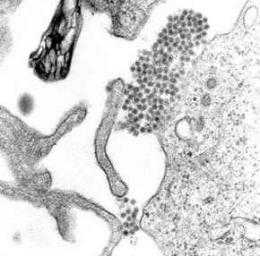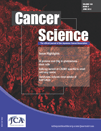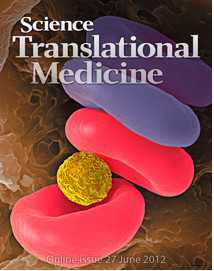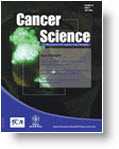Sci Transl Med:基因疗法能治愈尼古丁成瘾吗?
2012-07-03 EurekAlert! EurekAlert!
一项刊登在Science Translational Medicine上新的研究报告说,一种抗尼古丁抗体的基因疗法可阻止尼古丁进入脑部,并可能成为一个治疗吸烟成瘾的新的疗法。当吸烟者吸烟的时候,尼古丁会跨经肺部并在几秒钟内进入血流。这种成瘾性的药物会找到其进入脑子的途径并附着在奖励受体之上并引发快感,而这种快感会驱使吸烟者点燃另外一根香烟。科学家们最近一直在探索一种抗尼古丁疫苗的理念,这种疫苗可阻
一项刊登在Science Translational Medicine上新的研究报告说,一种抗尼古丁抗体的基因疗法可阻止尼古丁进入脑部,并可能成为一个治疗吸烟成瘾的新的疗法。当吸烟者吸烟的时候,尼古丁会跨经肺部并在几秒钟内进入血流。这种成瘾性的药物会找到其进入脑子的途径并附着在奖励受体之上并引发快感,而这种快感会驱使吸烟者点燃另外一根香烟。科学家们最近一直在探索一种抗尼古丁疫苗的理念,这种疫苗可阻止尼古丁进入脑内。
遗憾的是,制备疫苗的典型的方法,即注射某种病原体的一部分或一种病原体的灭活株以触发某种免疫反应——即产生抗体——对尼古丁不奏效。尼古丁是如此地细小,这使得免疫系统无法发现它,因此较难产生对其的抗体。此外,所产生的非常少数的抗体存在时间短暂。Martin Hicks及其同事尝试了另外一种方法:基因疗法。研究人员采用某种抗尼古丁抗体的基因序列并将其塞入某种基因疗法的载体之中。
他们将该载体注射到对尼古丁有依赖性的小鼠体内。一旦得到治疗,这些小鼠的肝脏会持续性地制造这种抗体。这种抗体会像游戏里的食豆人那样在血液中飘浮,特异性地与尼古丁结合并防止其进入脑内。该抗体可将脑内的尼古丁浓度减少至未经治疗的小鼠的脑内尼古丁量的一个百分数(15%)。在未来的试验中,Hicks及其同事计划在大鼠和非人类的灵长类中测试他们的基因治疗方法。

doi:10.1126/scitranslmed.3003611
PMC:
PMID:
AAV-Directed Persistent Expression of a Gene Encoding Anti-Nicotine Antibody for Smoking Cessation
Martin J. Hicks1,*,†, Jonathan B. Rosenberg1,*, Bishnu P. De1,*, Odelya E. Pagovich1, Colin N. Young2, Jian-ping Qiu1, Stephen M. Kaminsky1, Neil R. Hackett1, Stefan Worgall1,3, Kim D. Janda4, Robin L. Davisson2,5 and Ronald G. Crystal1
Current strategies to help tobacco smokers quit have limited success as a result of the addictive properties of the nicotine in cigarette smoke. We hypothesized that a single administration of an adeno-associated virus (AAV) gene transfer vector expressing high levels of an anti-nicotine antibody would persistently prevent nicotine from reaching its receptors in the brain. To test this hypothesis, we constructed an AAVrh.10 vector that expressed a full-length, high-affinity, anti-nicotine antibody derived from the Fab fragment of the anti-nicotine monoclonal antibody NIC9D9 (AAVantiNic). In mice treated with this vector, blood concentrations of the anti-nicotine antibody were dose-dependent, and the antibody showed high specificity and affinity for nicotine. The antibody shielded the brain from systemically administered nicotine, reducing brain nicotine concentrations to 15% of those in naïve mice. The amount of nicotine sequestered in the serum of vector-treated mice was more than seven times greater than that in untreated mice, with 83% of serum nicotine bound to immunoglobulin G. Treatment with the AAVantiNic vector blocked nicotine-mediated alterations in arterial blood pressure, heart rate, and locomotor activity. In summary, a single administration of a gene transfer vector expressing a high-affinity anti-nicotine monoclonal antibody elicited persistent (18 weeks), high titers of an anti-nicotine antibody that obviated the physiologic effects of nicotine. If this degree of efficacy translates to humans, AAVantiNic could be an effective preventative therapy for nicotine addiction.
本网站所有内容来源注明为“梅斯医学”或“MedSci原创”的文字、图片和音视频资料,版权均属于梅斯医学所有。非经授权,任何媒体、网站或个人不得转载,授权转载时须注明来源为“梅斯医学”。其它来源的文章系转载文章,或“梅斯号”自媒体发布的文章,仅系出于传递更多信息之目的,本站仅负责审核内容合规,其内容不代表本站立场,本站不负责内容的准确性和版权。如果存在侵权、或不希望被转载的媒体或个人可与我们联系,我们将立即进行删除处理。
在此留言














#TRA#
63
#Transl#
52
#Med#
60